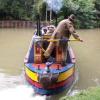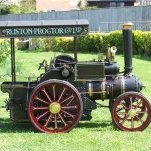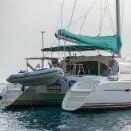Leaderboard
Popular Content
Showing content with the highest reputation on 01/10/17 in all areas
-
There is a place for wide beam boats but the north Oxford Canal is definitely not one. Despite the published dimensions of 2.1m beam and 21.9 length, it would seem that CRT have not objected to these boats being moored at Dunchurch Pools [Onley "Monster Marina"] and Barby Moorings. On my return trip to Cropredy last week, I saw 4 wide beams in Dunchurch and 2 in Barby. The former's entrance from the canal has clearly been constructed to allow these boats to gain access and egress. The local licensing officer even said there was nothing they could do. Really? But let's look at the real issue, and disregarding the fact that only narrow beam boats can travel through Hillmorton Locks: the canal profile is totally unsuitable for anything over 6ft 10" nominal beam! Several pinch points exist which will render meeting a wide beam an accident waiting to happen include a. the length between bridge 90 and 89, with 14 day mooring and overgrown offside vegetation, b. between bridges 83 and 84, again overgrown vegetation on the offside, not to mention the slope of the towpath edge c. the blind approach to bridge 80, only recently repaired. CRT have said they doubt if these boats will actually go out, but I do know that Dunchurch have constructed a wide beam slipway so we can expect movement along this 3 mile section. I for one would not want to come up against a wide beam at the locations noted above. An even worse scenario would be one going down to Hillmorton, finding they cannot go further the trying to reverse back to Tarry's bridge winding hole. Maybe it is time to campaign for a narrows to be constructed at bridge 90 of 8ft beam. I'm sure it would get the support of most narrow beam boaters.7 points
-
Probably not a lot of point until boaters and their interests are given receive more attention. Its no use bragging about 300, 400, 600 boats attending unless there is more for the boaters than evening entertainment they can not get into, expensive food, and a degree of daytime entertainment. Not everyone is likes sitting in a bar all day drinking. I am still trying to work out what Chity Chity Bang Bang and a couple pretending to be drunk wandering about has to do with boating. At last at Crick there is more than one chandlery type stall, unlike later nationals. I tried my best to provide something for boaters at no cost, apart from the pitch, to the IWA but they eventually wanted paying for that as well as me giving my time and expertise. Personally I suspect what is needed is not more Nationals but a new IWA that is not in CaRT's pocket, has developed some teeth, and pays more attention to boaters and canal restoration interests. At present it looks more like a sideshow to me.6 points
-
Fortunately not true, and both our ex working narrow boats, built to 7' 0.5" beam, (but one of them now definitely wider), are no less suited to the canal than the now accepted 6' 10" beam chosen for most modern leisure narrow boats. Having got that out the way, I am otherwise in agreement with you, and find it most unsatisfactory that CRT are prepared to allow the use of the Northern Oxford by wider beamed craft. It is a stupid idea, and should not be happening. IMO CRT should not be prepared to let marinas built on this canal house these boats, unless there is a clear condition specified that they are never going to leave those marinas. Yes, but there are some fairly horrendous pictures doing the rounds of some incidents involving these boats cruising the Northern Oxford. One of the better ones shows the resulting chaos when a loaded motor / butty pair on a long line encountered one at a point that was simply not wide enough. The canal was certainly not built with anything other than narrow boats in mind, and they should not b on it.4 points
-
In other words, nothing whatsoever to do with canals and boating. It would be a much cheaper option to put residential caravans in Hyde Park to help the London housing crisis, rather than clogging up the canal system. George3 points
-
2 points
-
As a confirmed narrow boater and student of canal history with little interest outside of narrow craft made from steel or timber you might think it's obvious where my sympathy will lie. However I don't agree with the premise of the OP at all. In 50 years since the end of wholesale commercial carrying we have gone from the threat of little or no craft on the waterways to worrying about what sort of boat can go where. The true threat to canals is from under use not over use or perceived inappropriate use. The rise in demand for boats is a product of our time and things will not be so favourable regarding the usage of canals forever. In some places it still isn't and the threat of consequences of underuse are real. Be thankful for what we have. The 'blame' for this situation lies with the Grand Union company; it was they who opened up north of Braunston for wider craft with their ill-fated widening of the Napton & Warwick and Warwick & Birmingham canals. Before that I believe the stop narrows at Braunston toll house was only wide enough to pass narrow beam boats. Personally I think it a great shame this scheme ever happened. However we can't change the fact that it did happen and we must deal with the consequences. It was also that scheme which gave rise to the real anomaly in this debate; namely that the section of the south Oxford between Braunston and Napton that is part of the wide route from London to Birmingham is surely even less suited to wide beam craft than the north Oxford beyond Braunston? As for the issue of Berkhamsted being the northerly limit for wide beam craft I don't believe that the intention of either the Grand Junction company in 1800 or the Grand Union company in 1930 was that their wide locks would never be used by wide craft. It was lack of demand requiring such that caused that. There also was a time in history when wide boats did trade to Braunston in small numbers. Today there is a demand for wider craft and the principal problems around the movement of wide craft are dredging and vegetation management which are eminently solvable. This section of canal may never be ideal for wide craft but that it is delicate point since it can easily be argued that craft longer than 57' in the north or ex-GUCCCo boats on the BCN are not suited to those canals yet such craft do operate in those areas. And there is unlikely to be any craft on the network with more potential for causing damage than a butty crewed by volunteers. So I would say put the effort into campaigning for dredging and particularly vegetation management instead of telling others where they should or shouldn't take their boats. Ultimately it may just be doing canals more harm than good. JP2 points
-
Not true, it is possible to live aboard quite comfortably without a stove Phil2 points
-
This post cannot be displayed because it is in a forum which requires at least 10 posts to view.
-
Ok,so, started painting the inside of my boat this morning and got to wondering whether I should be painting the spiders the same colour as the background, or be picking them out in something different. It is not a historic boat, but I thought there might be some more experienced boaters on the forum with views on the correct approach. We are on the Great Ouse, not the canals, so it is an EA area rather than CRT. Ta.1 point
-
OK, so I am not necessarily expecting responses to this thread, it's a bit of a ramble as I know it will be easier to comment if you know where and how I intend to use the boat, so description goes before going into detail... and I'm a bit of a rambler anyway..... but if anyone feels like taking some time to give any advice it will be greatly appreciated. I'm buying a boat - deposit down, pending survey. I intend to live on it, on a CC licence (based in the SE, coming in and out of London, but I don't particularly want to hang out centrally, much, nor on the Lea that much - I work from home mostly and I think I will prefer quieter, less populated areas, further out West, and pop in centrally now and then to see friends. I went with head over heart, and went for what I think is a very decent 45 foot wide beam, less than 10 years old, 2 packed from the off, gas, heating (Kabola), 12v (only) electric and water all professionally installed, very neatly and *simply* (even I can understand what's going where!). Been looked after, engine is immaculate. The rest of the fit out is amateur, but very solid indeed, using good quality materials, T & G panelling etc BUT I don't particularly like the interior and am intending to change it. In fact, what with the carpet that's been applied to below the gunwhales and beside the doors, along with that on the floor, the lounge has THREE shades of brown carpet in one room! Mmmmmm lovely. Also, portholes only, and rather gloomy. To be honest, I would like to keep things simple, and am happy to leave some things as are. But there are some things I want to do. Not much in the way of direct questions here, but plenty to comment on if anyone feels so inclined: 1. Cut two windows in (where there are currently portholes) - I'm in touch with Martin Kedian and intend to do it "his" way, either by hiring him in or he has kindly offered to "remotely advise", I presume for a fee. At this stage the plan is to put in thermal break double glazing from Wesley Windows. [Kedian engineering use a Rage saw to cut through steel and fit out, avoiding the heat issues of a torch, and also the time issues of a grinder]. I am not the handiest 2. Cut some type of hatch or skylight - probably a Houdini hatch, but also considering a pigeon or dog box, depending on price - any opinions on this? Light is the main thing, I want as much light as possible. Again, this is something I've discussed with Martin Kedian, and an option would be for me to send him a cardboard roof profile and he will send the plinth to bolt onto the roof, onto which the hatch can be fitted (again, cutting using a Rage saw). There are two small prisms fitted into the ceiling, which must help, but not that much - I've been in the boat on a sunny day and it was still gloomy. Maybe if they were fitted so that they protruded from the ceiling, rather than inset as they currently are, that might help...? 3. Replace the carpet in the lounge, galley, bathroom and corridor - both on the floor and the vertical carpet. I am thinking that a floating, engineered floor would be the best bet. Not a massive fan of fitted carpets, but it's the mud and damp issues that really clinch it for me. Any advice about this would be appreciated. Bathroom can be lino, I figure, and I'll probably not change it otherwise. I don't love the style but it's neat and tidy and in good nick, so I think I'll leave it as is, barring switching out the carpet 4. Take out breakfast bar and reposition fridge (currently under breakfast bar), possibly keeping cupboards, possibly replacing, definitely replacing worktops. I will in all likelihood want to be able to rearrange ballast - so may choose to cut some panels into the floor. There is aready one bang in the middle of the galley part of the lounge, and I think put the flooring round it, and cut something to size to bring it to the same level, then cover it with a mate, or something - good for keeping the galley floor dry, anyway. But, along the sides, might be trickier, in terms of cutting the hatches, then laying the floor on top but so you can remove inspection hatches. Any ideas? One thing a mate said to me was that considering I am not very experienced at DIY (not completely useless, but not far off), I might be well advised to get someone else in to do all this and get it all done in a week. Does that sound realistic? Thanks!1 point
-
That to me i s the perfect answer, basically don't do it. Unless you know every piece of electrical equipment you are going to install and their specifications in advance and exactly where they are going to be fitted. If you do know that then I applaud you for being an exceptional human being The basics of 12v wiring aren't that difficult as I was told when I started fitting out for 90% of it its basically Red wire out Black wire returns, the other 10% you can get from books or from this forum. I went for these https://www.bluesea.com/products/category/25/22/DC_Panels/WeatherDeck Used 2 of them on a reverse layout fit out 6 position just inside rear door (8 would of been better for expansion) for the Lounge and Kitchen and centre roof lights-(For full length of boat), horn, front spotlight, navigation Also used a separate 3 position bilge switch and the ran a thick cable half way up the boat 6 position half way up the boat to connect up Cooker ignition, Shower Pump, Water pump, bedroom side lights, bathroom side lights, alde thermostat and pump and an Led light string. Relatively easy then to do the bulk of the wiring to(black wire) and from(Red wire) the panels. No need for a loom and allows maximum flexibilty in positioning of items. What I did get wrong was no allowing enough trunking for expansion. Doing it again I would; a Have trunking, approx 3 " wide, along both sides of the boat roof with wood cover that was easy to remove and replace. I also ran the 240v under the gunnel, because that is one thing that once done tends to be fixed for good, easy enough to fit the 240v wiring during the fit out but a pain to get at once done. That's a broad outline that should cover the bulk of the work. Technical details on wire sizing, Bus bars, connection to batteries, where you should not run the 12v wires i.e some regulations I believe on closeness to gas pipes and restrictions on running near insulation etc can all be answered on here by better qualified people than me. One thing I did do right, in my opinion, was to buy my cabling in spools,bulk buy good quality spade crimps and buy good quality crimping tools, you will be doing a lot of crimping. Note on 240v I believe that all 240v cables have to be crimped, this requires special crimps and a special crimp tool. Happy to stand corrected on whether this is a requirement but I was advised to do it and am pleased that I did. Hope this helps you to get started, honestly it isn't that difficult and has the advantages of flexibility during fit out, a full understanding of how you boat is wired, a reserve of wire and crimps for later use and the some quality tools if(should say when, based on my experience) when you need to add circuits at a later date all these advantages for probably less than the price of a loom and the adjustments you would need to make to it. OH and anuver fing Recommend all internal lights are LED Don't recommend LED for front Tunnel light, halogen far better and engine is running when your going through a tunnel so no drain on battery however does require a geet big cable, but that's another thread that has already be done and im sure will be done again. Now ask about toilets1 point
-
I've written on this before, but we owned the GUCCC widebeam craft Progress that was used for the ceremonial opening of the widened section Braunston-Birmingham at Hatton in 1937. We cruised London to Braunston several times in the 60s and on up to Camp Hill twice. Progress was 74' x 12'6". FMC also had an experimental craft Pioneer, but that was broken up by the time we came onto the canals late 50s. That said, Progress and Pioneer were both experimental craft and the experiment was abandonned as it was too problematic for the standard narrowboat traffic at bridges and tunnels in particular. I love wide beam vessels and we worked several in the London area. Our ex-partner Tim Wood still continues with some 4 Leeds and Liverpool shortboats and a couple of Dutch work flats we brought over in his WHH fleet of maintenance craft, though we took ourselves off to France where a wide craft is in its proper element. I do have to agree that although the Grand Union can cope with a handful of wide vessels it is not practical for there to be as many as there are now unless at least major dredging and tree lopping operations were to be carried out. tam1 point
-
There is now a new forum bylaw, all post titles to be pmd to Mr Oss for inspection and approval. Or he will get upset. No creativity, no seductive teasers, no smart Alec gimcrack one liners. Be staid and sensible lads. Wear your underpants outside your trousers while posting.1 point
-
Why not put large windows in the lounge and galley areas and leave the portholes for the more private areas of the boat? Looks better and more practical than large windows everywhere.1 point
-
I have a very strict rule. I throw them at the wall and if they don't stick they're still clean!1 point
-
1 point
-
Well yeah you probably are thinking of someone else. BUT even if I did I HAVE EVERY F'IN RIGHT TO! as does everyone else. And how else does anyone get from Northwich to Leigh and back again? Do the 150 mile 200 lock 4 week detour or pay 20 quid? Yeah well they can suck my socks I'm NOT paying it1 point
-
This post cannot be displayed because it is in a forum which requires at least 10 posts to view.
-
Having started, where would we have stopped ? English O level = 2 years Country Court = County Court Aires = Heirs etc etc.1 point
-
Or how about CaRT emphasising the no widebeams north of Berko recommendation? Oh look! Up there!! In the sky!!! Oink, flap. Oink flap1 point
-
Anybody who made the mistake of visiting that disastrous last National at Watford would have realised what a spectacularly bad idea it was, and just how far things have moved on whilst the IWA has remained stuck in time, resting on its former laurels. The sight of a band of IWA grandees in their blue sweatshirsts milling around in a large marquee where they outnumbered visitors by at least 2 to 1 demonstrates just how far they were out of touch with most boat owners these days. Lines of turnstiles, (yes honestly), that almost nobody passed through told a real story. My view is that event was a near perfect model of how not to do things, (and how to squander large amounts of cash at the same time), and a pretty fair indicator that whatever boaters and the public want, that certainly wasn't it. Once you were inside, despite all the spend, there really was little to attract and keep you there. Admittedly I'm biased, because I feel the IWA has lost it's way, still seeking to be some kind of exclusive body that has CRT in its pocket, with little concept now that there are huge swathes of boaters out there who simply don't agree with the policies and aims of such an organisation, (let alone some of the more bigoted types allegedly speaking on behalf of the organisation). I'm sure the IWA still has many excellent people at grass roots level - well actually I know it has. However would I now be tempted to some mega event promoted by the IWA? I would need some persuading!1 point
-
Umm - you didn't ask, but Does the engine / starter have its own dedicated battery? If NO then that's not a good idea, flat or well discharged main batteries (and you will get that situation, means you can't start the engine to charge them. If yes to the above then 2 x 110 Ah is not really adequate for your load. Your question was about the leisure bank, but you included the starter motor in the question, which I probably have misinterpreted....1 point
-
I agree amp hours out will be accurate but what real practical use is that to the average boater who has little understanding of batteries and no easy way of knowing the battery capacity at that time? As an example lets take a 110Ah battery that is a year or so old. It is mots likely that the capacity is rather less than 100Ah so lets say 90Ah because of sulphation but it could well be a lot lower. The boater knows from here and elsewhere that its not a good idea to discharge below 50% so discharges by 50 Ah, that is more than 50% of the capacity at that time. OK so over discharging by 5Ah is unlikely to produce a noticeable loss of cyclic life but next year it will be worse and so it goes on. It will be even worse if the batteries are not fully charged to start with. Likewise I agree that the Ah in figure will accurately sow the amps flowing into the battery over time but what it can not give is an accurate figure for how many of those amp hours have been converted to stored chemical energy. Simply relying on the Ah meter and charging until the AH in equalled the last Ah out reading will result in less than fully charged batteries. In my view for all practical purposes such gauges in the hands of typical boaters a shown by so may battery posts here do in effect tell lies so to avoid the pitfalls ordinary boaters are best advised to only rely upon amps and volts for battery monitoring.1 point
-
sometimes a change as simple as moving from one side of a pontoon to the other can make all the difference for being able to get into a mooring as for any given place there will be one direction that the wind usually comes from, in the case of our marina the wind usually comes from the south (in 3 years I have only once had the wind coming from a different direction when trying to moor). our mooring is on the right of the pontoon (south side) and has never presented a problem to get the boat into (even if the approach angle is interesting), our neighbours who both moor on the left of the pontoons (north side) and often cannot get into their moorings1 point
-
I would simply change mooring. Most bowthrusters are too puny to make any discernable difference in high winds anyway. A hydraulic thruster would be better but cost a fortune to retro fit. If you must have one even though they are rarely of any use it would probably be easier to sell your boat and downgrade to a boat fitted with one.1 point
-
We have had Wesley thermal break windows for about 3 years now, bloody brilliant!!!1 point
-
Osmosis is unlikely to be the reason boats are stored ashore, if that was the case The Broads would have a problem as there is not enough hard standing available fir a fraction of the boats afloat there. Usually when GRP boats are lifted and stored ashore it enables work to be done on the hull, antifoul etc and to avoid issues with raw water cooling systems from freezing particularly the weed filters. Phil1 point
-
Fridge - easy, 1sq mm CCSA for each meter between source and fridge so 8 sq mm conductor cross sectional area for both pos and neg. The BSS demands (I think) a minimum of 25 sq mm CCSA for battery & startser cables. That has a NOMINAL rating of 170 amps so that shoudl be fine for the interlinks, starter and battery cables. I would probably use the same for the inverter as we can estimate it demands about 120 amps at full output.1 point
-
I would use 50mm2 for everything (size based on your inverter) apart from the fridge where I would use around 8-10mm2 to avoid voltage drop.1 point
-
We've had one made for our semi-trad. Wouldn't be without it. Gives us an extra room when we moor up for the night and with two dogs that is important. Couple of things that we specified to make it convenient. Firstly, front screen can be completely zipped out so that with side screens removed as well, it just provides a canopy for shade or shelter from showers. On wet days on the Thames (where bridges are higher) we can cruise with the canopy up. Secondly, to ensure that the stainless steel hoops do not obstruct access to the boat, the hoops are on sliding rails on the sides of the semi-trad. Hence when the canopy is laid down the hoops slide forward, keeping the whole thing clear of the access hatch. Ours in canvas. more flexible for folding down. When we moor I can have the whole thing up, screen and sides fitted and water-tight in about 5 minutes. Ours was made by Tim at AM Marine Trim, based at Windsor Marina.1 point
-
That is the problem with a thread like this. Osmosis is blown up into something it is not. Probably 90%+ of osmotic problems are purely cosmetic with the blisters forming just under the gel coat level, caused by small air bubbles swelling with water. They can reasonably easily be repaired and will never sink the boat as the damage is not structural. They will have appeared long before the boat gets to 40 years old. On less than 10% of the osmotic problems, the voids that are the sites of the blisters could be larger and MAY lead to some structural problems but not always. There are always horror stories but Osmosis is not the boat killer some people on here make out. Maybe a few percent of osmosis problems could kill a boat. Now, your boat is nearly 50 years old so will be hand laid up with likely a thick laminate. Today GRP boats are made with laminate thicknesses almost a thrid of the thickness. It is very difficult to have structural problems with a thick laminate and especially if a surveyor has said it is fine. Yes they do miss stuff but in this case I would not worry. In 1978 I built a canadian canoe - open top. It sat in our garden for 40 years filling up with water whenever it rained. 40 years on, not an issue with laminate performance - and it was built with gash resin, gash glass but with lots of skill!! You ask if it can be osmosis free. If it is not blistered now - yes. As I have said on multiple occasions in this thread, the biggest enemy is not osmosis but gel coat cracks that lets water wick up the fibres. Your surveyor should have spotted these and didnt, so likely not an issue. Even then, on your thick laminate, you are unlikely to have a problem. If you are in any doubt, go back and ask you surveyor about the structural integrity.1 point
-
It does smell like political spin to me, ie bunk. Looking at a model of annual PM2.5 levels, it shows that particulates are highly concentrated along the main roads: http://www.londonair.org.uk/london/asp/annualmaps.asp?species=PM25&LayerStrength=75&lat=51.5008010864&lon=-0.124632000923&zoom=12 So surely the biggest risk is surely to people living alongside these roads, from traffic on the roads themselves. The old joke about politicians lying comes to mind. Though it would make sense to mandate any new stoves installed in the worst areas should be clean burning DEFRA approved ones.1 point
-
1 point
-
This post cannot be displayed because it is in a forum which requires at least 10 posts to view.
-
I've downloaded all 6 episodes. Watch W1A if you want to understand why TV schedules are now a bit old fashioned .1 point
-
Not really mentioned, I think, is whether the boat, after fitting out, and being loaded with all your wares, is not sitting at the right amounts in the water front to back, even if not listing to one side. IMO it is important to keep (particularly) the back end in to about the right depth, which I generally find for a modern boat is with the uxter plate, (bottom of counter) sat more on less on the water line. If you are in that lucky situation, then simply add trimming ballast as already described. However if you are already at the point where the bottom of the counter is well submersed, I would say ideally you need to get excess ballast out from the "heavy" side, rather than adding more to the "light" side. It's not generally a good idea to have boat ballasted lower than is necessary for the prop to get a good "grip" on the water, and if you keep draught as little as sensible, you will be able to moor close to banks where deeper boats fail. You should also also be mindful of how high the lip of your wed hatch is above the water, and whether any vents or drains in the hull are sitting lower than is sensible.1 point
-
1 point
-
This post cannot be displayed because it is in a forum which requires at least 10 posts to view.
-
This post cannot be displayed because it is in a forum which requires at least 10 posts to view.
This leaderboard is set to London/GMT+01:00


















